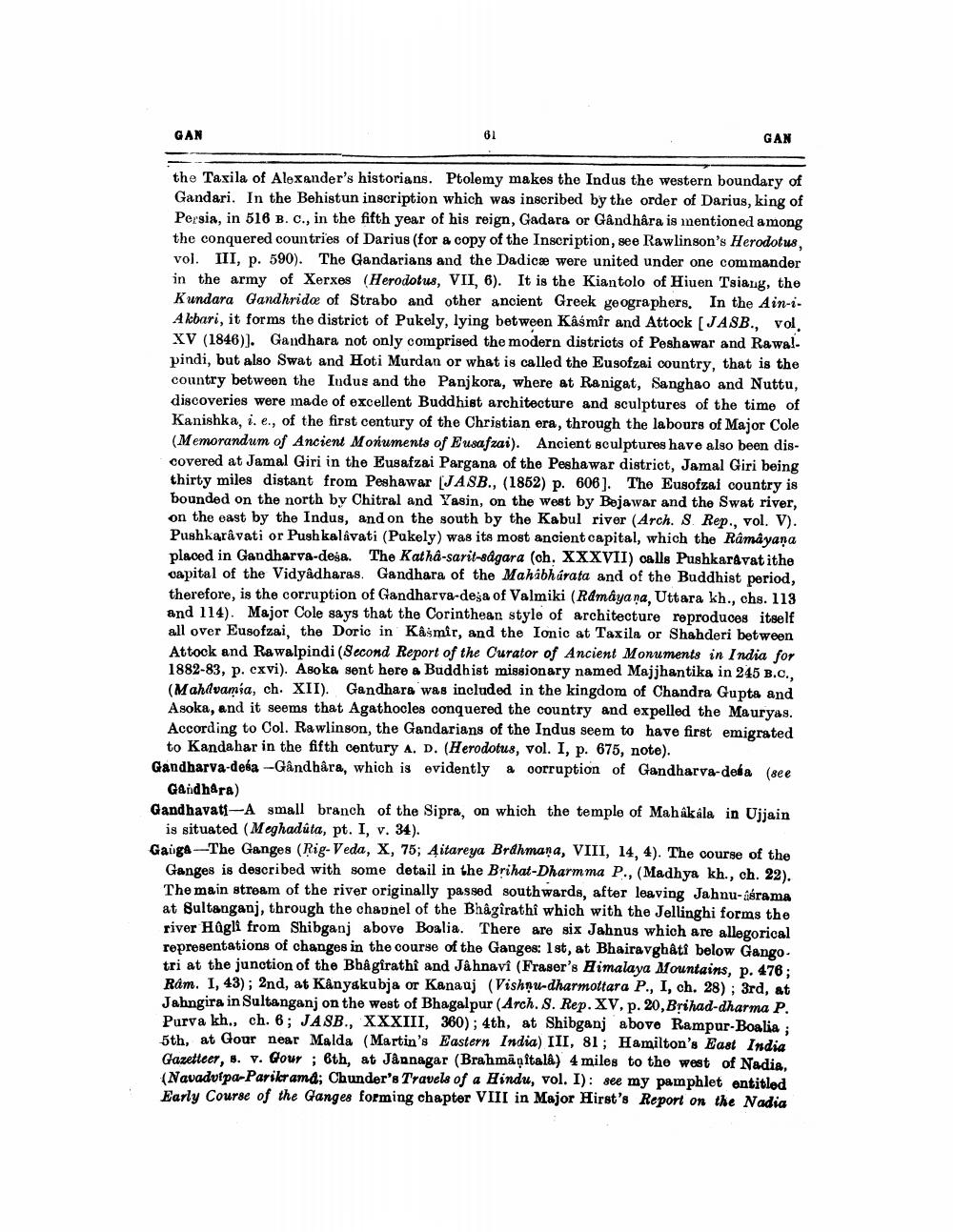________________
GAN
GAN
the Taxila of Alexander's historians. Ptolemy makes the Indus the western boundary of Gandari. In the Behistun inscription which was inscribed by the order of Darius, king of Persia, in 516 B. C., in the fifth year of his reign, Gadara or Gândhâra is mentioned among the conquered countries of Darius (for a copy of the Inscription, see Rawlinson's Herodotus vol. III, p. 590). The Gandarians and the Dadicæ were united under one commander in the army of Xerxes (Herodotus, VII, 6). It is the Kiantolo of Hiuen Tsiang, the Kundara Gandhride of Strabo and other ancient Greek geographers. In the Ain-i. Akbari, it forms the district of Pukely, lying between Kâśmir and Attock [JASB., vol. XV (1846)]. Gandhara not only comprised the modern districts of Peshawar and Rawal. pindi, but also Swat and Hoti Murdan or what is called the Eusofzai country, that is the country between the Indus and the Panjkora, where at Ranigat, Sanghao and Nuttu, discoveries were made of excellent Buddhist architecture and sculptures of the time of Kanishka, i.e., of the first century of the Christian era, through the labours of Major Cole (Memorandum of Ancient Monuments of Eusafzai). Ancient sculptures have also been discovered at Jamal Giri in the Eusafzai Pargana of the Peshawar district, Jamal Giri being thirty miles distant from Peshawar (JASB., (1852) p. 606). The Eusofzal country is bounded on the north by Chitral and Yasin, on the west by Bejawar and the Swat river, on the east by the Indus, and on the south by the Kabul river (Arch. S. Rep., vol. V). Pushkarâvati or Pushkalâvati (Pukely) was its most ancient capital, which the Ramayana placed in Gandharva-desa. The Kathâ-sarit-sagara (ch. XXXVII) calls Pushkarávat ithe capital of the Vidyadharas. Gandhara of the Mahabhárata and of the Buddhist period, therefore, is the corruption of Gandharva-desa of Valmiki (Ramayana, Uttara kh., chs. 113 and 114). Major Cole says that the Corinthean style of architecture reproduces itself all over Eusofzai, the Doric in Kasmir, and the Ionic at Taxila or Shahderi between Attock and Rawalpindi (Second Report of the Curator of Ancient Monuments in India for 1882-83, p. cxvi). Asoka sent here a Buddhist missionary named Majjhantika in 245 B.C., (Mahavamsa, ch. XII). Gandhara was included in the kingdom of Chandra Gupta and Asoka, and it seems that Agathocles conquered the country and expelled the Mauryas. According to Col. Rawlinson, the Gandarians of the Indus seem to have first emigrated
to Kandahar in the fifth century A. D. (Herodotus, vol. I, p. 675, note). Gandharva-desa --Gândhâra, which is evidently a corruption of Gandharva-deka (see
Gandh&ra) Gandhavati-A small branch of the Sipra, on which the temple of Mahakala in Ujjain
is situated (Meghadüta, pt. I, v. 34). Gauge --The Ganges (Rig Veda, X, 75; Aitareya Brahmana, VIII, 14, 4). The course of the Ganges is described with some detail in the Brihat-Dharmma P., (Madhya kh., ch. 22). The main stream of the river originally passed southwards, after leaving Jahnu-israma at Sultanganj, through the chapnel of the Bhagirathi which with the Jellinghi forms the river Hügli from Shibganj above Boalia. There are six Jahnus which are allegorical representations of changes in the course of the Ganges: 1st, at Bhairavghati below Gango. tri at the junction of the Bhagirathi and Jâhnavi (Fraser's Himalaya Mountains, p. 476; Ram. I. 43); 2nd, at Kanyakubja or Kanaaj (Vishnu-dharmottara P., I, ch. 28); 3rd, at Jahngira in Sultanganj on the west of Bhagalpur (Arch. S. Rep. XV, p. 20,Brihad-dharma P. Purva kh., ch. 6; JASB., XXXIII, 360); 4th, at Shibganj above Rampur-Boalia ; 5th, at Gour near Malda (Martin's Eastern India) III, 81; Hamilton's East India Gazetteer, s. v. Gour ; 6th, at Jannagar (Brahmäņítalà) 4 miles to the west of Nadia. (Navadvipa-Parikrama; Chunder's Travels of a Hindu, vol. I): see my pamphlet entitled Early Course of the Ganges forming chapter VIII in Major Hirst's Report on the Nadia




